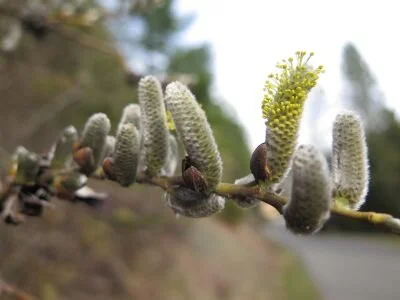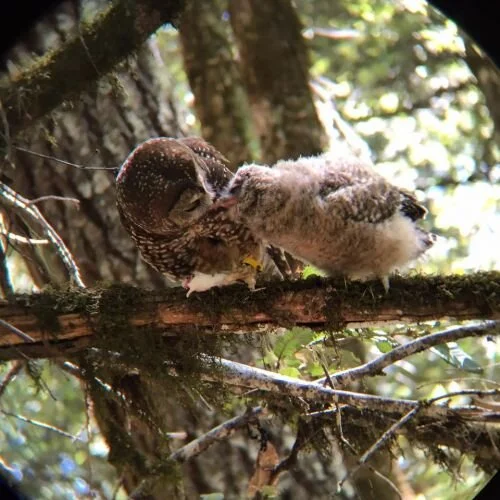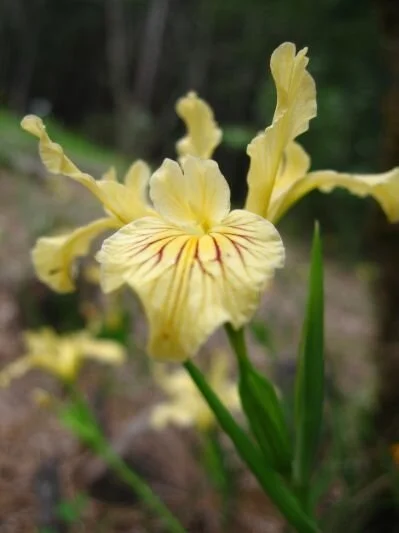When we compromise, we may get our needs partially met, but not completely. This is not the WKRP model of collaboration. At WKRP workshops and meetings, there is a culture of only moving forward if we are in agreement. People who work together in this process often say: we “don’t have to give up an arm or a leg” to work together. This model of collaboration represents a breakthrough.
Read MoreThese habitats along the margins of a stream may not look like much to a casual onlooker, but when your whole world revolves around survival against steep odds, these side-channel sanctuaries can make a big difference, and in the world according to salmon, every little bit helps.
Read MoreWe face a fire and fuel problem in the Klamath Mountains. Over a century of fire suppression and laws stopping prescribed burning has created a tinderbox around our communities. It is just a matter of time before these overly dense forests go up in smoke. I have a hard time viewing these trees as having sequestered carbon, as the fire reality we face makes the carbon seem pretty active, or ready to be released into the atmosphere as greenhouse gas emissions.
Read MoreThe Valley Fire in Middletown was described as the third most destructive on record in the state, but it was just one of several large incidents that CALFIRE managed that year. Everyone at the conference was trying to figure out what made this fire so destructive. Was it just a freak of nature, or was this going to be the new normal for fire behavior in California?
Read MoreThat little peach boy is why I am plunking away at my computer on this absolutely gorgeous day. To see their little faces light up as they dig in the dirt and get DIRTY..to watch kids who “don’t like GREEN THINGS” gobble down some fresh made pesto they helped grow and make…to see the amazement on her face when she sees the pea starts in the window moving towards the sunlight and exclaims “They’re moving!…They’re ALIVE!”
Read MoreThe catkin appears to be an example of convergent evolution; this reproductive mechanism evolved at least twice, once for the order Fagales (oaks, hazel, alder) and again for Salicaceae (willow, cottonwood).
Read MoreA lot of us live remotely, surrounded by creeks and rivers, forests and mountains. Living “in” the Klamath creates strong connections. Our food and energy systems rely on it; our water, often taken from springs, is a signal of our relationship, particularly during these last dry years. Many subtle changes occurring simultaneously are easily overlooked and then there are the more dramatic changes, the fires and floods, snowstorms, rockslides, births and the deaths. All are encompassed within this river of time.
Read MoreQuitting fishing so early in life remains one of my biggest regrets. But if I’ve learned anything, it’s that you don’t have to slay fish, or even live in the Klamath to love what the people and salmon who live here represent. I love to see the shadowy shapes of wild salmon spiraling around in a deep hole in the river. I love to know that they’re there. I love that they spend their whole lives trying to get home, much as the rest of us seem to do. I love the cultures that have evolved around salmon in this place. Mostly, I love that catching them is the best therapy for my brother. And maybe someday his kids will have the patience to teach me to fish and I will feel brave enough to try again.
Read MoreThe journey of Klamath salmon is nothing short of miraculous. It is believed they swim thousands of miles by navigating the stars and smelling their way back to their home streams—all for the promise of procreation. Salmon are anadromous, meaning they are born in freshwater, migrate to the ocean, and then return to freshwater to spawn.
Read MoreRemember, this was in the sixties, you were still pretty young. And I was just a child. Simplistic messages appealed to me. Your story and message were compelling but did not paint the whole picture. We know better now. Smokey, we have both grown up.
Read MoreBy providing a place for community events along the Klamath, MKWC hopes to provide a spark of revitalization in Orleans. MKWC has tried to clean up from past land uses and is endeavoring to set an example for responsible land use and increasing community vitality. As an organization we have much to contribute and high hopes for the future, but as the saying goes, it takes a village.
Read MoreThe Klamath-Siskiyou Outdoor School is a cost free overnight camp for youth in the Mid Klamath area. The camp involves local youth, ages 11-14, in hands-on natural resource restoration and monitoring activities during rafting and backpacking trips. Students learn about the natural history and ecology of the Klamath area from camp counselors and special presenters. In addition, students participate in outdoor recreational activities such as kayaking and stand-up paddle boarding. Junior counselors, who were campers in previous years, are given the opportunity to improve and practice their leadership skills. KSOS aims to inspire the next generation of environmental stewards, while providing a platform for building self-confidence and strong relationships.
Read MoreThe NSO calls the Pacific Northwest home, where it is considered a keystone species and is currently listed under the Endangered Species Act as ‘threatened.’ Loss of habitat over the past century, and, more recently, the invasion of the Barred Owl (Strix varia) from the East have led to a sharp decline in the population of this splendid raptor.
Read More…Most westerners are unaware of prehistoric extreme climate events that complete the regions long-term climate pattern. During millennia, climate has often varied by extremes in the American West. Close examination of the evidence suggests that the benign past century and half have not prepared us adequately for what could come in the future
So wrote B. Lynn Ingram and Frances Malamud in the book Roam, The West Without Water, What Past Droughts, Floods and other Climatic Clues Tell Us About Tomorrow.
Read MoreIris tenax ssp. klamathensis is an example of an endemic plant. Endemism is when an organism has a restricted range, found in only one region and not outside of that location. The Klamath Siskiyou biogregion is home to many endemic species because of its unique geography. And to me, the Orleans Iris is the flower shaped shining star that reminds me how special this place we live really is.
Read MoreEvery year, I hear people asking and concerned about the foam they see on the Klamath. They want to know if it’s toxic, something to stay away from, why don’t they see it on other local rivers, will it kill my dog? As it turns out, these are pretty good questions. And they’re probably questions I can’t answer – completely.
Read MoreAfter another dry January, I felt giddy as the Klamath River started rising in February. I compared stories with friends about which house-sized rocks were quickly going underwater. I feel this excitement was warranted because when all was said and done, the flows were three times higher than the highest flows last year (which were dismal.)
Read MoreLast August 4, a handful of local firefighters were gathered at the Pigeon Shoot, a rickety wooden platform built atop a rock outcrop on a knife edge ridge just east of the Rainbow Mine, the first private property to be threatened by the White’s Fire. Located in the headwaters of the North Fork Salmon River in the east side of the Middle Klamath River watershed, this fire spread rapidly through forests where fires had been effectively excluded since fire suppression was invented over a century before.
Read More

















